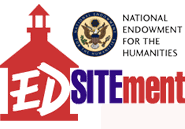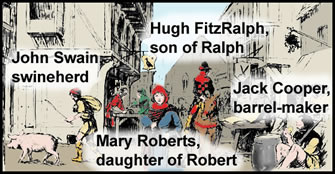 |
 |
| |

|
| |

|
| |
Last names as we know them now originated in the Middle Ages from people’s occupations, where they lived, their father’s first name, or even their appearance or disposition.
|
| |
| |
| Subject Areas |
| Art and Culture
|
| |
Anthropology |
| History and Social Studies
|
| |
World History - Asia/Far East |
| |
World History - Europe |
| |
| Time Required |
| |
Activity 1: 90 minutes
Activity 2: 60 minutes
Activity 3: 60 minutes
Activity 4: 60 minutes. |
| |
| Skills |
| |
Interpreting and analyzing written and oral information
Making inferences and drawing conclusions
Vocabulary development
Cross-cultural connections
Research
Working collaboratively
Categorizing
|
| |
| Additional Data |
| |
Date Created: 06/17/03
|
|
What’s In A Name?
—Curriculum Unit Overview—
Introduction:
MacDonald. Carpenter. Underwood. Green. These are typical American names that reflect a family's British origins—but they tell us little about the people who currently bear them. How times have changed! In the Middle Ages, a person's second name served a useful function. In some cases, it revealed where he lived; in others, it told who his father was, what he did for a living, or even what he looked like.
In this unit, students will learn about the origins of four major types of British surnames. They will consult lists to discover the meanings of specific names and later demonstrate their knowledge of surnames through various group activities. They will then compare the origins of British to certain types of non-British surnames. In a final activity, the students will research the origins and meanings of their own family names.
Guiding Questions:
What are the origins of British surnames?
What did these names once tell about the people who bore them?
What similarities exist between British and non-British surnames?
How can we find the origins of our own surnames?
Learning Objectives:
When students finish this unit, they will be able to:
- Explain how and why surnames came to be
- Describe four types of British surnames and give examples of each
- Compare the derivations of British and certain non-British surnames
- Tell the origin and meaning of their own surnames
Preparing to Teach this Lesson:
Become familiar with the materials used in the lesson plan. Locate and bookmark websites you plan to use. Download and duplicate charts used in Activities 1, 2, 3, and 4. Secure several copies of a local phonebook for the Assessment exercise in Lesson 3.
You can find additional background information about surnames at the following sites:
Unit Lesson Plans
Extending the lesson:
My Family Name
- Have the students research the origins and meanings of their own surnames, consulting the websites used in Activities 1-4. Additional information can be found at Genealogy Resources by Region/Country available through Internet Public Library. Then have them share what they've learned about their personal genealogical backgrounds.
- As a follow-up, you might have the students design family crests, which provide visual clues to the meaning of their surnames.
- Learn about the origins and meanings of first names. A good place to start is Behind the Name, a link available through the Internet Public Library.
- Find out where clusters of people having certain common surnames live in our country by accessing US Surname distribution, also available through Internet Public Library.
Selected EDSITEment Websites:
Other Information
Standards Alignment
- NCSS-1
Culture and cultural diversity. more
- NCSS-2
Time, continuity, and change. The ways human beings view themselves in and over time. more
- NCSS-3
People, places, and environments. more
- NCSS-9
Global connections and interdependence. more
- NCTE/IRA-6
Students apply knowledge of language structure, language conventions (e.g., spelling and punctuation), media techniques, figurative language, and genre to create, critique, and discuss print and nonprint texts. more
- NCTE/IRA-7
Students conduct research on issues and interests by generating ideas and questions, and by posing problems. They gather, evaluate, and synthesize data from a variety of sources (e.g., print and nonprint texts, artifacts, people) to communicate their discoveries in ways that suit their purpose and audience. more
- NCTE/IRA-8
Students use a variety of technological and information resources (e.g., libraries, databases, computer networks, video) to gather and synthesize information and to create and communicate knowledge. more
- NCTE/IRA-9
Students develop an understanding of and respect for diversity in language use, patterns, and dialects across cultures, ethnic groups, geographic regions, and social roles.
- NGS-10
The Characteristics, Distribution, and Complexity of Earth’s Cultural Mosaics
- NGS-4
The Physical and Human Characteristics of Places
- NGS-9
The Characteristics, Distribution, and Migration of Human Population on Earth’s Surface

|


